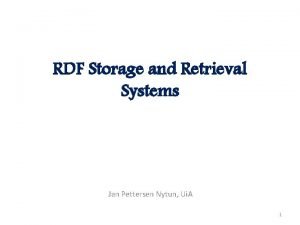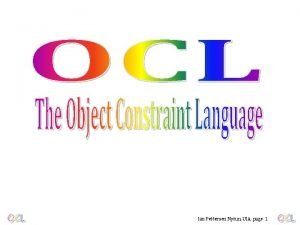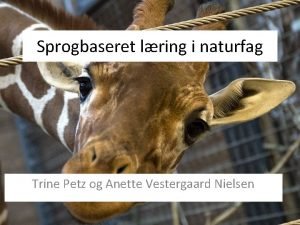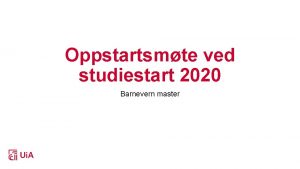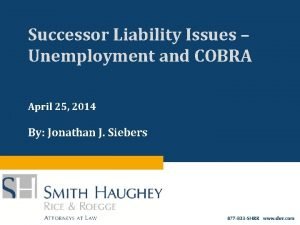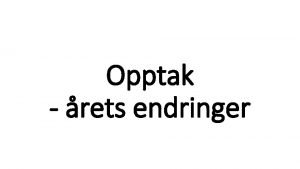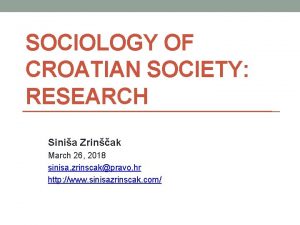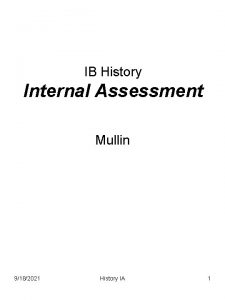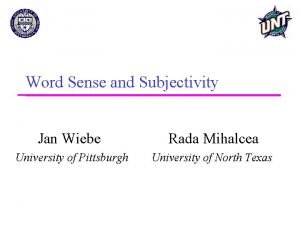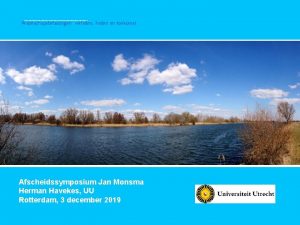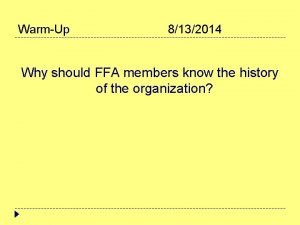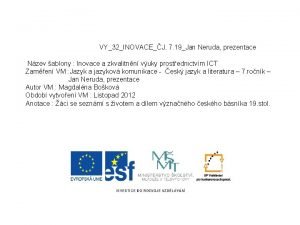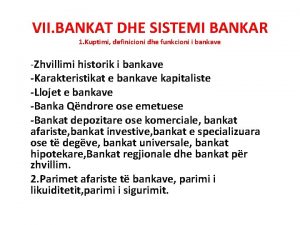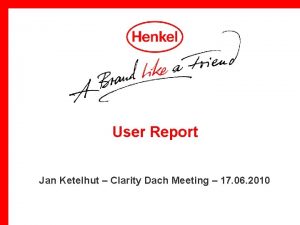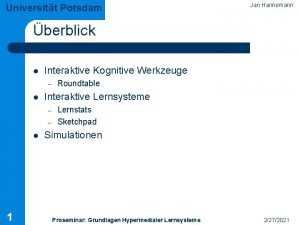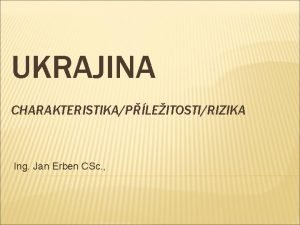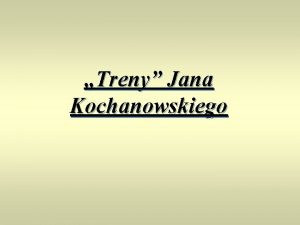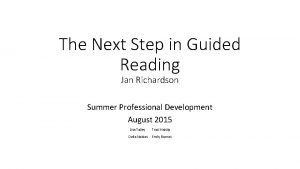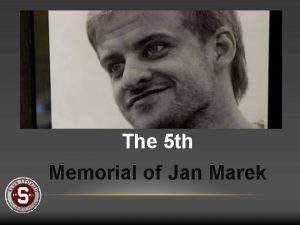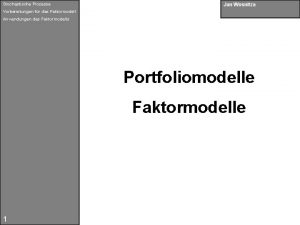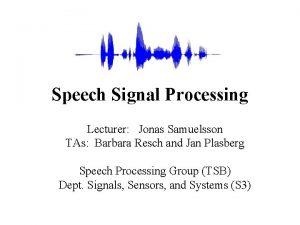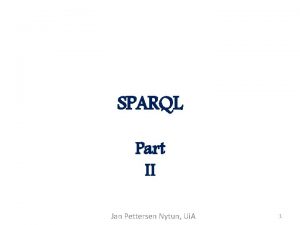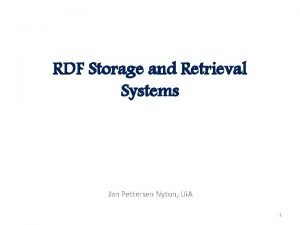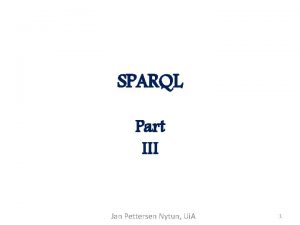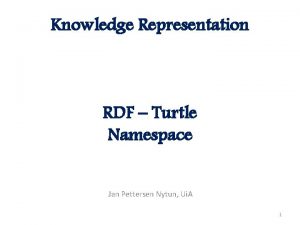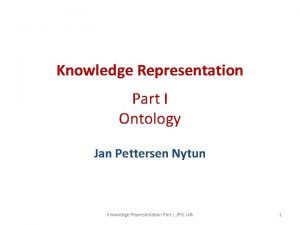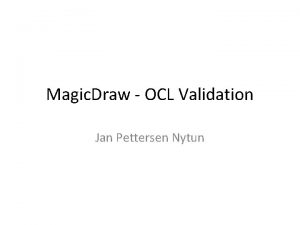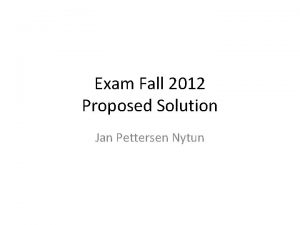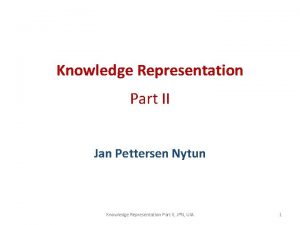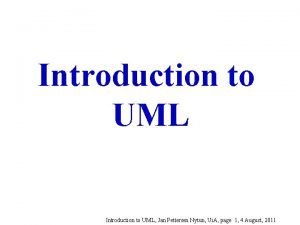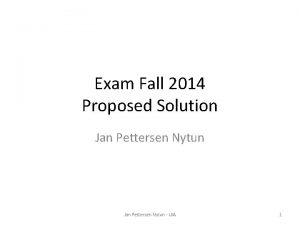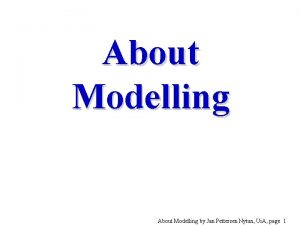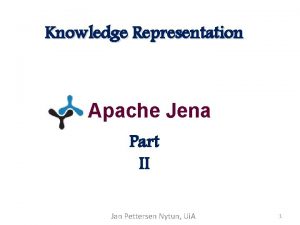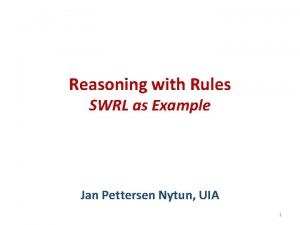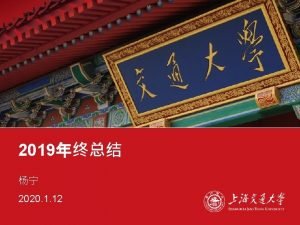Jan Pettersen Nytun UIA page 1 Content HISTORY






![Self [2]: ”Each OCL expression is written in the context of an instance of Self [2]: ”Each OCL expression is written in the context of an instance of](https://slidetodoc.com/presentation_image_h/f99fdc9731fb223e7b77f2329e6419ff/image-7.jpg)














![Constraint [1]: … condition or restriction represented as an expression…. can be attached to Constraint [1]: … condition or restriction represented as an expression…. can be attached to](https://slidetodoc.com/presentation_image_h/f99fdc9731fb223e7b77f2329e6419ff/image-22.jpg)













- Slides: 35

Jan Pettersen Nytun, UIA, page 1

Content • HISTORY • COLLECTION TYPES AND QUERING IN OCL • FORMAL LANGUAGE - STATEMENT EXAMPLES • CONSTRAINTS AND OCL • EXAMPLES Jan Pettersen Nytun, UIA, page 2

History • Formal Languages like Z, have for a long time (ca. 1970) been used to describe things in a precise and unambiguous way. • OCL was developed by IBM (1995) and is a part of UML. • It emphasize precision and simplicity There is no use of special mathematical symbols. Jan Pettersen Nytun, UIA, page 3

Aligning OCL with the OO-Concepts Level Class Property Ass. OCL 2 (metamodel) the class concept the property concept association concept an OCL construct as a concept 1 a specific class a specific property a specific association OCL Formulas 0 an object of a class a slot with value a link between objects a formula instantiated Jan Pettersen Nytun, UIA, page 4

Content • HISTORY • COLLECTION TYPES AND QUERING IN OCL • FORMAL LANGUAGE - STATEMENT EXAMPLES • CONSTRAINTS AND OCL • EXAMPLES Jan Pettersen Nytun, UIA, page 5

Some Collection Types in OCL • A Set is the mathematical set (no duplicate elements). • A Bag is like a set, which may contain duplicates (i. e. , the same element may be in a bag twice or more). • A Sequence is like a Bag in which the elements are ordered. Both Bags and Sets have no order defined on them. Jan Pettersen Nytun, UIA, page 6
![Self 2 Each OCL expression is written in the context of an instance of Self [2]: ”Each OCL expression is written in the context of an instance of](https://slidetodoc.com/presentation_image_h/f99fdc9731fb223e7b77f2329e6419ff/image-7.jpg)
Self [2]: ”Each OCL expression is written in the context of an instance of a specific type. In an OCL expression the name self is used to refer to the contextual instance. ” context Gang inv: self. member… Gang member 1. . * 0. . * Gang. Member When self is A: Gang then self. member is: Set{@M 1, @M 2} : Set(Gang. Member) self. member self M 3: Gang. Member B: Gang model instance (example) M 1: Gang. Member A: Gang M 2: Gang. Member M 4: Gang. Member M 5: Gang. Member

One More Navigation Example Model Quiz * * Question contex Quiz inv: self. question. alternative… When the complete constraint is checked, then self is bound to one Quiz object at a time and then the constraint is checked for that bound object. self. question alternative * 1. . * Answer. Alternative incomplete constraint self. question. alternative quiz 2: Quiz q 3: Question a 4: Answer. Alternative self. question. alternative quiz 1: Quiz q 1: Question a 1: Answer. Alternative a 2: Answer. Alternative q 2: Question a 3: Answer. Alternative


The Example continues… Using OCL as a Query Language: Finding all members no matter which Gang they belong to OCL is case sensitive! Using USE as OCL tool.

Alternative way to find all members no matter which Gang they belong to Single navigation of an association results in a Set. Combined navigations results in a Bag

Allowing a Member to be Member of Several Gangs belonging to two gangs Jan Pettersen Nytun, UIA, page 12

Allowing a Member to be Member of Several Gangs belonging to two gangs Jan Pettersen Nytun, UIA, page 13

as. Set Jan Pettersen Nytun, UIA, page 14

Jan Pettersen Nytun, UIA, page 15

Finding all members of the B-gang

Content • HISTORY • COLLECTION TYPES AND QUERING IN OCL • FORMAL LANGUAGE - STATEMENT EXAMPLES • CONSTRAINTS AND OCL • EXAMPLES Jan Pettersen Nytun, UIA, page 17

Logical implication – p implies q p q If p is true then also q must be true. “p q” is called a predicate A predicate is a statement that may be true or false depending on the values of its variables.

Universal Quantification: In predicate logic, universal quantification formalizes the notion that a logical predicate is true for all the values that can be bound to the variable. E. g. : a Integer | (a > 10) (a + 1 > 10) Can be read as: For all a of type Integer the following is true: if a is greater then 10 then a +1 is also greater then 10 Jan Pettersen Nytun, UIA, page 19

Example: Transitivity In logic and mathematics, a binary relation R is transitive if x. Ry and y. Rz together imply x. Rz In predicate logic: a, b, c X | a R b b R c a R c Less than (<) is a transitive relation: a, b, c Integer | a < b b < c a < c In english: For all Integer a, b, c the following is true if a < b and b < c then also a < c (e. g. , 1<2 2<4 1<4) Is mother of a transitive relation? Jan Pettersen Nytun, UIA, page 20

Content • HISTORY • COLLECTION TYPES AND QUERING IN OCL • FORMAL LANGUAGE - STATEMENT EXAMPLES • CONSTRAINTS AND OCL • EXAMPLES Jan Pettersen Nytun, UIA, page 21
![Constraint 1 condition or restriction represented as an expression can be attached to Constraint [1]: … condition or restriction represented as an expression…. can be attached to](https://slidetodoc.com/presentation_image_h/f99fdc9731fb223e7b77f2329e6419ff/image-22.jpg)
Constraint [1]: … condition or restriction represented as an expression…. can be attached to any UML model element…. indicates a restriction that must be enforced by correct design of the system… Jan Pettersen Nytun, UIA, page 22

Why OCL? • The power of the graphical part of UML is limited! • OCL gives you power to improve the documentation in a precise and unambiguous way. • OCL parsers (/ evaluators) ensure that the constraints are meaningful and well formed within the model. • To do MDD the models have to be unambiguous (e. g. , when doing code generation, transformations). Jan Pettersen Nytun, UIA, page 23

Where To Use OCL? ü Invariants on classes and types ü Precondition and postconditions on operations (methods) ü Constraints on operations: operation=expression (the return value) ü… Jan Pettersen Nytun, UIA, page 24

Content • HISTORY • COLLECTION TYPES AND QUERING IN OCL • FORMAL LANGUAGE - STATEMENT EXAMPLES • CONSTRAINTS AND OCL • EXAMPLES Jan Pettersen Nytun, UIA, page 25

An Invariant Example: Use of Size An invariant is predicate that is always true (i. e. , when the system is at “rest”. ) Gang. Member name : String is. Army : Boolean +member 1. . * 0. . * register(new. Member : Gang. Member) -- The gang is an army if there are more than 100 members. context Gang inv one. Simple. Constraint: self. is. Army = (member->size() > 100) Jan Pettersen Nytun, UIA, page 26

Use of pre –and post-condition Gang. Member +member 1. . * 0. . * name : String is. Army : Boolean register(new. Member : Gang. Member) -- The gang has grown with one when a new member has been added. -- NB! @pre accesses the value before executing the operation context Gang : : register(new. Member : Gang. Member) pre: not member->includes(new. Member) post : member = member@pre->including(new. Member) Jan Pettersen Nytun, UIA, page 27

Comments to Previous Slide collection->includes(object: T): Boolean is True if object is an element of collection. E. g. : Set{@m 1, @m 2}->includes(@m 2) = true p@pre refers to the value of p before the operation was executed. E. g. : member@pre is the set member before the operation was executed. collection->including(object: T): Bag(T) is the bag with all elements of collection plus object. E. g. : Set{@m 1, @m 2}->including(@m 3) = Set{@m 1, @m 2, @m 3}. Jan Pettersen Nytun, UIA, page 28

Using OCL in USE What we want: An account has either a person as owner or a cooperation as owner context Account inv : person. Owner->size() = 1 implies cooperation. Owner->size() = 0



What is this? This should not be allowed – this is not xor!

Modify the Constraint: context Account inv: (person. Owner->size() = 1 implies cooperation. Owner->size() = 0) and (person. Owner->size() = 0 implies cooperation. Owner->size() = 1)

for. All Variations (math. notation: ) Person age : Integer employee * * Company context Company inv: self. employee->for. All( age <= 70 ) { Equivalent Constraints context Company inv: self. employee->for. All( p | p. age <= 70 ) context Company inv: self. employee->for. All( p : Person | p. age <= 70 ) Jan Pettersen Nytun, UIA, page 34

Example: exists (math. notation: ) collection exists(exp : Ocl. Expression) : Boolean True if exp is true for one elements of the collection -- Every Gang must have a member with a car contex Gang inv: member->exists(car->size()>0) Jan Pettersen Nytun, UIA, page 35
 Jan pettersen
Jan pettersen Nuka deti
Nuka deti Helge pettersen
Helge pettersen Avh bygg og vedlikehold as
Avh bygg og vedlikehold as Trine dyrstad pettersen
Trine dyrstad pettersen Helge egil seime pettersen
Helge egil seime pettersen Uia lisieux
Uia lisieux Smittevernkurs uia
Smittevernkurs uia Uia form 1027
Uia form 1027 Opptakskontoret uia
Opptakskontoret uia Carrier content vs real content
Carrier content vs real content Dynamic content vs static content
Dynamic content vs static content Content page magazine
Content page magazine School magazine cover
School magazine cover Does apa have a title page
Does apa have a title page What is content analysis
What is content analysis Ib history ia rubric
Ib history ia rubric Checkpagerank.net
Checkpagerank.net Also history physical
Also history physical Jan wiebe
Jan wiebe Pan tadeusz pełny tytuł
Pan tadeusz pełny tytuł Berend jan spijkerboer
Berend jan spijkerboer Jan monsma
Jan monsma National ffa alumni association was formed
National ffa alumni association was formed Jan neruda prezentace
Jan neruda prezentace Llojet e bankave
Llojet e bankave Robbert jan boswijk
Robbert jan boswijk Jan clevers
Jan clevers Jan ketelhut
Jan ketelhut Jan hannemann
Jan hannemann Jan erben
Jan erben Najkrótszy tren kochanowskiego
Najkrótszy tren kochanowskiego Jan richardson sight words
Jan richardson sight words Jan marek memorial
Jan marek memorial Jan wosnitza
Jan wosnitza Jan plasberg
Jan plasberg
